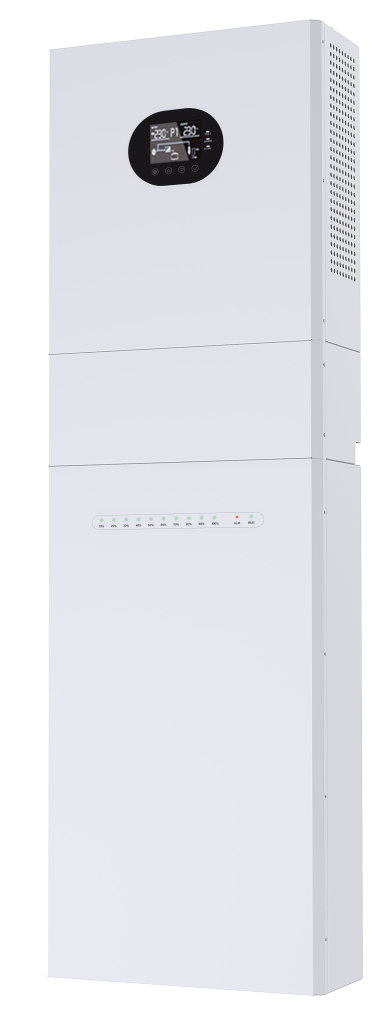
Amid growing demand for energy independence and simplified renewable solutions, the all-in-one off-grid system emerges as an integrated answer. It consolidates solar generation, storage, and management into a single, plug-and-play unit, making reliable off-grid power more accessible than ever.
What is an Off-Grid All-in-One System?
An off-grid all-in-one solar system is a complete energy solution that integrates power generation, storage, and supply into a single unit. It combines solar charging systems, large-capacity batteries, and smart inverters in one device, offering a true “plug-and-play” experience.
Typical application scenarios include remote homes and vacation cabins, agricultural irrigation and farming operations, emergency power supply for disaster relief, mobile power needs for RVs and boats, as well as temporary power for construction sites and outdoor events.
Key Components of Off-Grid All-in-One Systems
High-Performance Lithium Batteries
The system utilizes safe and reliable LiFePO4 battery cells with a cycle life exceeding 6,000 cycles. Supporting deep discharge capabilities, it offers over 95% usable capacity and incorporates multiple temperature protection mechanisms to ensure operational safety.
Smart Inverter System
Equipped with a pure sine wave inverter compatible with various electrical appliances, it achieves over 95% conversion efficiency to minimize energy loss. The system also features precise voltage stabilization and frequency regulation functions to provide reliable protection for sensitive equipment.
Battery Management System
The built-in precision BMS continuously monitors the status of each cell. It provides comprehensive protection against overcharge, over-discharge, overcurrent, short circuit, and extreme temperatures, while its automatic cell balancing feature effectively extends the battery pack’s service life.
MPPT Controller
Utilizing high-efficiency MPPT controller technology, it achieves up to 99% solar conversion efficiency. The wide voltage input range accommodates various solar panel types, while intelligent algorithms ensure real-time maximum power point tracking to significantly enhance power generation efficiency.
How Off-Grid All-in-One Systems Work
In daytime operation mode, solar panels generate electricity that is optimized by the MPPT controller, simultaneously meeting real-time power consumption needs and battery charging requirements. The system prioritizes solar energy usage while automatically storing excess power.
During nighttime operation, the system automatically switches to battery power, converting DC to AC through the inverter to provide continuous power supply to devices. Intelligent power output regulation effectively extends operation time.
In special operation scenarios, the system automatically issues alerts when battery levels are low, can connect to generators for supplementary charging, and supports prioritized power supply to critical loads.
Advantages of Off-Grid All-in-One Systems
Easy Installation
The pre-assembled design reduces connection points by 80%, cutting installation time from 3 days for traditional systems to just half a day. Even non-professional electricians can complete the installation easily.
Space Saving
Compared to split systems, it saves 60% of installation space. Supporting various installation methods including wall-mounted and floor-standing options, it adapts flexibly to different site conditions.
Simple Operation
With one-touch startup enabling automatic operation, combined with mobile APP for remote system monitoring, the built-in self-diagnostic function makes daily maintenance simple and convenient.
Flexible Expansion
Supporting battery module stacking for capacity expansion, it can be paralleled to form larger capacity systems while remaining compatible with various solar panel specifications to meet future upgrade needs.
How to Choose an Off-Grid All-in-One System
Define Power Requirements
Create a detailed list of commonly used appliances and their usage time, accurately calculate total daily power consumption, and fully consider the impact of seasonal electricity usage variations on the system.
Determine System Specifications
Select appropriate battery capacity based on total electricity consumption, determine inverter size according to total equipment power, and configure adequate solar panels considering local sunlight conditions.
Focus on Key Parameters
Pay close attention to battery cycle life and warranty period, focus on inverter output waveform and conversion efficiency, and verify system protection ratings and relevant safety certifications.
Consider Expansion Needs
We recommend reserving 20%-30% power margin, selecting products that support modular expansion, and ensuring the system has good upgrade compatibility.
Selecting the Right System for Your Home
For average household users, we recommend choosing between our two main product configurations:
[5kW + 5kWh All-in-One System] – Perfect for small homes and basic power needs
• 5kW output power, 5kWh storage capacity
• Ideal for lighting, refrigeration, and essential appliances
• Compact design for space-limited installations
• Learn more: All-in-One Home Energy System: 5kW Inverter & 5kWh LiFePO4 Battery | ELB Energy Group
[11kW + 16kWh All-in-One System] – Designed for larger homes and high power demands
• 11kW output power, 16kWh storage capacity
• Handles air conditioning, water pumps, and multiple appliances
• Superior expansion capabilities for future needs
• Learn more: All-in-One Home Energy System: 11kW Inverter & 16kWh LiFePO4 Battery | ELB Energy Group
For regular household users, we generally suggest selecting systems with a capacity between 10-15kWh. The key is to ensure the inverter’s peak power can meet the starting requirements of high-current equipment like air conditioners.
This guide will help you choose the most suitable off-grid all-in-one solar system based on your actual needs, enabling you to enjoy safe, stable, and economical clean power.





